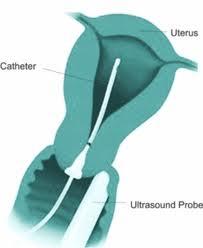


1. What is SSG?
SSG stands for Saline Infusion Sonography. It is a test done to diagnose any lesions inside the uterine cavity like polyp, fibroid, adhesions and also helps in checking if the tubes are open on either side.
2. How is it done?
Prior to test, injections are given to reduce pain that might be felt during procedure.
Patient is made to lie down and a narrow tube is inserted gently into the uterus.
Normal saline is then passed through the tube and vaginal ultrasound is done simultaneously.
As the cavity distends, any uterine cavity lesions can be diagnosed.
Fluid that is passed into the uterine cavity is checked for spill around the ovaries. Presence of spill indicates that the tubes are open
3. Is it painful?
SSG is associated with mild pain/discomfort which can be handled by giving an analgesic prior to procedure. Pain is more so if both tubes are blocked and the fluid remains inside the cavity.
4. Can I get back to routine work after SSG?
SSG is an office procedure that does not require any anesthesia. Patient is allowed to return to routine work after procedure.
5. Any alternatives test to SSG?
HSG or hysterosalpingogram is a procedure similar to SSG wherein a radio opaque dye is passed into the uterus and an X Ray is done to test tubal patency. Diagnostic hysterolaparoscopy is the other alternative which is done under anaesthesia and tubal patency is confirmed.
6. What options do I have if my tube/tubes are diagnosed blocked on SSG?
Single tube block can still have chances for natural conception or IUI Both tubes blocked pregnancy can be planned through IVF/ICSI